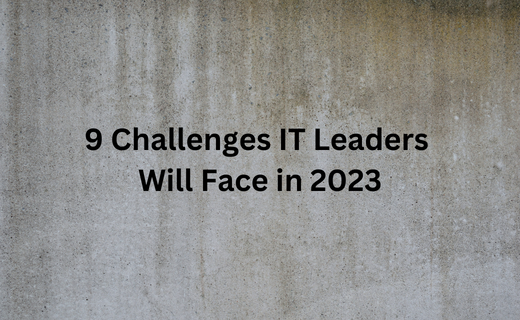-

9 Challenges IT Leaders Will Face in 2023
The COVID-19 pandemic forced companies to change their priorities. Three years ago, IT leaders were squarely focused on adopting fledgling AI techniques into their business models in service of digital transformations that included plans for shifting some workloads to the cloud. Now that the world has a semblance of normalcy, IT leaders are returning to the basics by focusing on recruitment, retention and adopting new technologies.
IT leaders are facing unprecedented challenges amid layoffs and a looming economic uncertainty. IT leaders are navigating the new dynamics of working with a distributed workforce while trying to make positive changes to their organizations’ work culture. Here’s how IT leaders plan to address the biggest issues they expect to face in the year ahead.
Economic Uncertainty
Organizations are concerned about multiple economic forces that are all causing uncertainty. How do you future-proof your business in the face of so much uncertainty? One clear thing is that organizations will need to partner and work across industries to solve the big problems they are collectively facing.
“Business leaders are figuring out how to weather a post-pandemic soft economy, looming recession, and inflation,” says Srinivas Mukkamala, chief product officer at Ivanti
The shifting economy presents an interesting opportunity now that things have begun to stabilize after the mass layoffs in big tech companies toward the end of last year.
“We need to improve overall performance while we adapt to the changing business environment. The good news is that, for managers, the best time to attract and retain talent is during economic downturns. Hiring and retaining the best people with the right skills is always the best strategy to improve overall performance.” says Grace Liu, senior vice president of IT for Seagate Technology.
“The recent layoffs and hiring freezes by the big tech companies have leveled the playing field somewhat. That’s allowed smaller tech startups to compete for the significant talent that these workers have and can provide,” says Elizabeth Hoemeke, CIO of One Inc.
The Need to Grow Smartly
Gil Westrich’s company, ClearML, is benefiting from the increased adoption of artificial intelligence and machine learning (ML) technology. But the CTO and co-founder of the company says that scaling to meet that demand presents challenges that require self-reflection.
“How do we grow our business responsibly?” he asks. “How do we get the talent we need? Given how competitive the technology and associated talent market is, companies have to clearly map out their plans for business growth, ensuring they are as comprehensive, considered, and responsible as possible. We want to make sure our roadmap is robust.”
Tyler Derr, chief technology officer at Broadridge Financial Solutions, is also concerned about how to address challenges that come with growth.
“Recent market volatility has added to the complexity of delivering high-quality products and services,” Derr says. “Organizations will need to consider when and how to invest in proprietary innovation or partner with industry-outsourced solutions balancing cost and speed to market while bringing to life a robust digital roadmap with clear and actionable objectives and key results.”
Making Remote Work Rewarding
The University of Phoenix CIO Jamie Smith says the institution, partly because of its commitment to online learning, is fully dedicated to a remote workforce including IT partly because of its commitment to online learning. But creating a strong work culture in a remote world requires an intentional approach that goes beyond what was sufficient when everyone was working together in person, he says.
“We hold regular virtual and in-person events designed to build and enhance our feeling of belonging and culture,” Smith says. “Since 99% of our students attend online, our new way of working has increased a deeper level of empathy for the need to create connection and engagement in a remote environment.”
Laserfiche CIO Thomas Phelps’ firm called to close its offices on Mondays and Fridays after reviewing data that showed the fewest employees were in the office on those days.
“Closing our offices made sense to conserve energy costs and give people the flexibility to come into the office any day from Tuesday through Thursday,” Phelps says. “Most departments try to have employees work a day or two in the office and schedule weekly team meetings in person if they are close to a physical location. This helps foster collaboration and mentorship aligned with our culture and values.”
Prithvi Mulchandani, vice president of IT business applications at Deltek, focuses on finding ways for remote tech staff to engage and collaborate better.
“We need to be prepared to help our employees be productive from any location — getting them the right tools and then ensuring those tools work for them no matter where they are located,” Mulchandani says. “CIOs and IT teams can support their teams by implementing and upgrading tools such as hoteling cube reservation systems, in-office audio and video conferencing solutions, and employee social recognition platforms.”
Rising costs
John Reeher, CIO and CISO at EstateSpace, says his organization made capital investments earlier in the year, reducing some sticker shock from inflation. But other areas of the business, he says, will still face challenges related to widespread rising prices.
“Inflation is a major issue for CIOs both in direct costs and labor,” Reeher says. “Technically just to keep employees salaries in line with the cost of living, they need an 8-9% raise. Inflation ties into retention. There are other companies out there willing to pay more to your employees because of a labor shortage. As an industry, we’ve set a bad precedent: If employees want a raise, they change jobs. A hot job market and inflation make it more likely for your best employees to be poached.”
Talent Arms Race
Talent recruitment is challenging every year. But the University of Phoenix’s Smith, like others we talked to, says he’s seeing more digital talent on the move, driven by near-term economics, making it difficult for IT departments to retain their best workers.
“Even on the doorstep of a potential economic downturn, we are seeing people leave for 40-60% more than market salaries across all technical disciplines,” he says.
Smith suggests that organizations must create an employee-first culture to help retain top performers. “Giving our best engineers meaningful problems to solve and an environment where they can do their best work has never been more important,” he says.
Dudek CIO Brian Nordmann agrees that attracting, engaging, and retaining talent to fuel growth will continue to be challenging in the next year.
“We are in the midst of a highly competitive job market,” Nordmann says. “But simply making sure you offer competitive compensation isn’t enough. Keeping staff engaged by ensuring a sense of community with their peers and providing them with interesting and rewarding work is critical in retaining top talent.”
Worker Burnout
Laserfiche’s Phelps is also concerned about the increasing number of tech workers suffering burnout. He says many people don’t realize the increased stress on IT teams that began during the pandemic and continues today due to the increased IT demands of their remote colleagues.
“Not only do you have to continue providing the same services for people who are fully remote or fully in person,” he says, “but now you have to sustain a collaborative work environment that combines elements of both and provide a rich, multi-architecture environment.”
Phelps gives the example of businesses that want to use both Teams and Zoom and have those platforms interoperate with conference room AV devices, which are not typically Zoom or Teams-native, he says. “Our support teams are constantly fine-tuning our tech stack and configurations to make sure the experience is fairly frictionless for employees and doesn’t impede their productivity,” says Phelps.
Managers can help by setting expectations for stressed-out IT staff who need downtime, says Cassandra Brown, Bitly’s vice president of engineering. “Have managers and leaders model for their teams by taking time for themselves and encouraging paid time off, mental health days, and meeting-free days.”
The Need for More Diverse Teams
Diversity remains an issue in the IT industry, especially as diverse teams have been shown to produce better outcomes. But diversifying the mix of IT workers remains challenging, especially given the previously mentioned pressures on the tech talent market. And that work goes beyond getting new talent in the door, also extending to creating a culture and employee experience that ensures all IT workers feel comfortable and productive and are motivated to stay.
For some organizations, establishing new relationships can help. Bitly’s Brown, for example, says her company is working to address a lack of diversity in its tech workforce in part through external partnerships.
“To be more intentional about diversity, equity, and inclusion, we start in the community,” Brown says, including working with organizations that offer developer training for women and underrepresented groups. “We also will continue our commitment to the success of our employee resource groups, pay equity, and diverse candidate sourcing.”
Security threats
Matt Mead, chief technology officer at SPR Consulting, expects increasingly sophisticated security threats in the next year.
“There is a clear trend that ultimate security responsibility is falling on the shoulders of CIOs and CISOs, so they’ll need to continue to look for ways to raise security posture without breaking the bank,” Mead says. “Don’t just focus on security personnel and tools; focus on the low-hanging fruit that can solve larger security issues, such as providing rigorous and ongoing security awareness to your entire organization. Your security posture is only as good as your weakest link, which is almost certainly your employees.”
Making the most of what the cloud offers — without breaking the budget
Mike Albritton, senior vice president of cloud at CData, says even for data-driven businesses, migrating certain business needs to the cloud can be daunting. Albritton says his company largely managed its business needs on-premises but has moved more of its business operations to the cloud in the past two years.
“Despite being a business built to solve the challenges of digital transformation, we also face the typical challenges surrounding cloud migration and adoption,” Albritton says. “Because we’ve been able to slowly ramp up our cloud strategy — and use our own data connectivity solutions to make the process smoother — we’ve been able to take most things one step at a time.”
And doing so is beginning to pay off.
“By incrementally implementing best practices like real-time data access, user permissions for various platforms, and cloud data warehousing, we’ve come to a place where those processes are now built into our foundations,” he says. “Our IT teams and individual team leaders can ensure that everyone has access to the data they need from the platforms they’re already using, minimizing disruption to operations and making it easy for lines-of-business employees to continue performing their day-to-day tasks.”
Balancing the finances of cloud migration and contending with rising cloud costs will be a significant issue for organizations in the year ahead. But with inflation and other factors pushing cloud providers to increase their prices in 2023, IT leaders must beware of budget creep. Cloud migrations can also be lengthy — and hefty — initiatives, leaving organizations waiting months or years for the promised ROI of a shift to the cloud to pay off, all while the meter runs.
Follow Us on LinkedInAbout the Author

Kamal Rastogi is a serial IT entrepreneur with 25 yrs plus experience. Currently his focus area is Data Science business, ERP Consulting, IT Staffing and Experttal.com (Fastest growing US based platform to hire verified / Risk Compliant Expert IT resources from talent rich countries like India, Romania, Philippines etc...directly). His firms service clients like KPMG, Deloitte, EnY, Samsung, Wipro, NCR Corporation etc in India and USA.